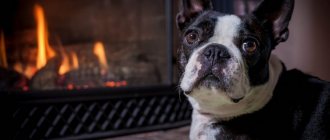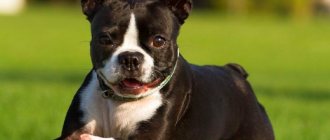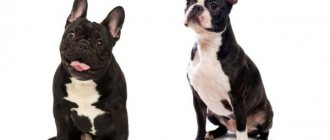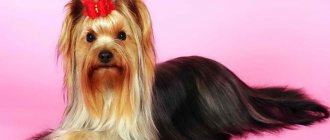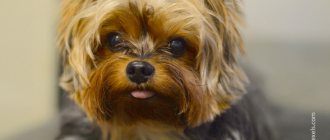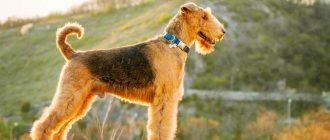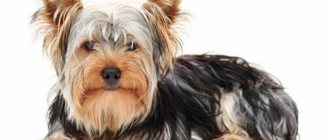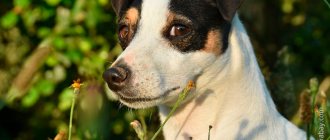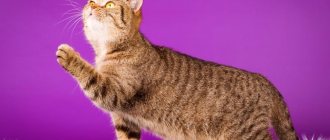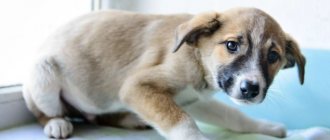Description of the Boston Terrier breed
Popularity 243rd place among 263 dog breeds
Lifespan:
11-15 years
Height:
23-38 cm
Country of origin:
USA
Average price:
40-50 thousand rubles
Weight:
3-11 kg
Latest articles Cat health
Rabies vaccination for cats: choice of vaccine, necessity, schedule 01/22/2022 4 0 0
Selection and adaptation
TOP 20 best cat breeds for families with children 01/22/2022 25 0 0
Key facts
Boston Terriers are friendly, active, small brachycephalic dogs. The description of the Boston Terrier breed is very reminiscent of the French bulldog, but only verbally - visually these dogs are easy to distinguish.
Representatives of the breed are delicate and courteous, and their coloring resembles a tuxedo, which is why they are nicknamed “American gentlemen.”
These dogs do not tolerate heat and cold well. In low temperatures they must be protected from hypothermia, and in the sun - from overheating. Dog clothes cope with this task.
Bostons have all the characteristics of brachycephals (snorting, snoring, a tendency to catch colds), except for one thing - their muzzle is dry, and they do not slobber all around. Many breeders note this as a definite plus.
The Boston Terrier is not a working breed, and if you want to develop some service qualities in it, then training is necessary for this. They are best equipped to protect their homes due to their strong territorial sense of ownership.
The characteristics of the Boston Terrier breed emphasize that the dogs are easy to maintain. They live in peace with other family members, including tailed and winged ones. Due to their docile nature, Boston dogs are great for families with children, retirees and inexperienced dog breeders.
Boston Terriers are not talkative, but they do make funny sounds like snoring or snorting all the time. People with light sleep will have a hard time with brachycephalus. Terriers love to put their paws on others as a sign of their affection - if you don’t like this, you need to pay attention to this moment in raising a puppy.
The Boston muzzle is extremely expressive. When a pet misbehaves, it is literally written on his face. The offended Boston makes such a sad face that all that remains is to start feeling sorry for him and treat him with treats.
You will have to carefully monitor your dog's health. Due to the characteristics of breeding, the breed has acquired a tendency to certain diseases that can be noticed and treated in time. At the same time, the life expectancy of the Boston Terrier is long, and if you take care of its health, it will live up to 15 years.
History of the origin of the Boston Terrier
The Boston Terrier is a completely man-made dog breed. The first representative was born in 1870 from the mating of an English bulldog and a now defunct English terrier. The unusual crossbred bribed Bostonian Robert Hooper, who purchased a dog named Judge from his friend William O'Brien.
This male was bred to the white feminine female Jip or Kate by owner Edward Burnett. Jip gave birth to a male, Wells Eph, who was bred to a small female, Tobin Keith. The puppies of this couple are considered the founders of the breed, since it was with them that targeted breeding began.
Initially, breeders of the new breed exhibited their pets under the name “round-headed bullies.” In 1889, the first American Bull Terrier Club was created, but the name was met with dissatisfaction from owners of existing English Bull Terriers who feared breed confusion. As a result, in 1891 the Club was renamed the Boston Terrier Club: the name of the breed was given by the city of origin.
Two years later, in 1893, the AKC recognized the new breed and entered it into the Stud Book, and club members were accepted into the ranks of the organization. The first official Boston is a male named Hector. In 1896, there were enough livestock to hold a special breed exhibition, where the best representative of the breed was the female Topsy.
Due to their size, easy-going nature and cheerful disposition, Boston Terriers have become very popular in the United States. In the first half of the 20th century, more Boston Terrier puppies were registered in America than any other breed. The prevalence of the breed subsided slightly only in the second half of the 20th century due to the Great Depression.
In Russia, the Boston Terrier was officially recognized by the RKF in 2002.
Interesting fact: in the USA, the Boston Terrier is the official symbol of the state of Massachusetts.
How to choose a puppy
Puppy and mom
- Believe only the documents provided by the seller: puppy metrics, veterinary passports, champion diplomas of parents. If, instead of documentary evidence, the breeder refers to rave reviews from past customers and his own competence in breeding matters, forget the way to him.
- Bitches of purebred Boston Terriers are infertile, so their litters usually contain 3-4 puppies.
- Breeders interested in quality offspring test Boston studs for hereditary diseases: deafness, heart pathologies, patella. If the owner of the kennel openly declares that he is financially unable to afford medical examinations and makes his own oaths to confirm the health of the puppies, it is better to refuse the purchase.
- Take a closer look at how the Boston Terrier puppy you like behaves in a group. If the baby is embittered and pugnacious, it is definitely not worth adopting, since aggressive representatives of this breed should not exist in nature.
- Boston Terrier puppies often have hunchbacks. In some children, the defect goes away as they grow up and strengthen their leg muscles, while in others it remains forever, blocking the animals’ access to exhibitions.
- A traditional Boston puppy should have a square body and large eyes, although in recent years several breed lines have appeared, the representatives of which are distinguished by small eyes and a relatively long body.
- And don't forget: a non-profit breeder always keeps the best puppies for himself, as his main goal is the further development of the breed. In addition, a true specialist is not indifferent to the future fate of the babies, so after the purchase, he “guides” the puppy for a year, advising the new owner free of charge on health, nutrition and pet care.
Similar dog breeds
Pug
English bulldog
French Bulldog
Border Terrier
Boston Terrier appearance
The Boston Terrier inherited the brachycephalic face and set of the front paws from the bulldog. The body is devoid of the dampness and stockiness of a bulldog - it is a fit dog with good muscles.
General impression
In the photo of Boston Terriers, it is noticeable that the males are larger and rougher than the females, which look very elegant. Due to its color resembling a tailcoat, the Boston Terrier is considered an American aristocrat, dandy and gentleman. It is often confused with the French Bulldog, but they are two completely different breeds.
Head
The Boston Terrier has a square head, with a short brachycephalic muzzle, a pronounced stop and distinct brow ridges. Under no circumstances should there be folds or “raw” jowls on the head.
The bite of this breed is straight, a slight undershot is possible, the teeth are small, 42 in number. The lower teeth are in a row.
The nose is wide, black, with a distinct stripe in the center. The eyes are almost round, spaced at a sufficient distance. Eye color is only dark. The look is clear and cheerful. The ears are erect, set wide and almost parallel. Can be cropped.
Neck
The neck is of medium length, with a pronounced scruff, without dewlap.
Torso
The body of the dog is square in format, bitches can be slightly elongated in length. The back is straight, ending in a slightly sloping croup. A hunched back is a vice. The chest is of sufficient width and depth and flows smoothly into a taut hemline.
Forelegs
Boston inherited his front paws from a bulldog. Slanted shoulder blades, backward elbows, short strong pasterns and a small, downed paw are characteristic features of the breed.
Hind limbs
Hind legs well muscled and well angulated, parallel and straight when viewed from behind. The paw is arched, with short claws. Dewclaws must be removed.
Tail
The tail is low-slung, can be straight or curled into a corkscrew, thin. The dog carries the tail below the line of the back.
Movements
Movements are free and energetic. A waddling gait is considered a defect.
Wool
The coat is without undercoat, straight and short, the awn lies close to the body. During molting it does not cause excessive trouble.
Color
The Boston Terrier has three standard colors:
- brindle;
- seal (dark brown color, which can be confused with black, but in bright light it casts red);
- black.
There must be white spots on the chest across the entire width, a white blaze on the muzzle between the eyes and on the forehead (preferably even), turning into the outline of the muzzle. Also desirable are white spots on the legs (on the hind legs - no higher than the hocks) and a white collar.
Size
Depending on their weight, Boston Terriers are divided into three categories: mini (up to 6.8 kg), standard (6.8-9 kg) and large (9-11.4 kg).
The height at the withers (aka the height of the Boston Terrier) ranges from 23 to 38 cm. Bostons have well-expressed sexual dimorphism - females are smaller, more graceful, with light bones. The size of male Boston Terriers is significantly larger.
Boston Terrier personality
The Boston Terrier is a sweet, completely good-natured creature, a favorite of children and adults. He is an excellent companion, completely devoid of anger, aggressiveness and hunting instincts. If you have a Boston, you will never be left without attention, he is friendly and treats everyone around him well.
The character of the Boston Terrier is not dominant; children are the best friends and playmates. Bostons get along well with other animals - both with their fellow tribesmen and with birds, cats, and rodents.
Bostons are calm about the absence of their owners: they will not howl or tear up furniture, but will happily sleep at home on their favorite sofa. If the owner often leaves for a long time, you can make a pet friend, and then they will not be afraid of any loneliness.
You can keep a Boston Terrier either in a small apartment or in a spacious country house, but it must be kept at home. Boston walks quite moderately; in your home you can limit yourself to a walk in the yard for toilet purposes. In winter, these short-haired dogs freeze outside, so it is better to insulate them - dress them in a special overall.
Who is the Boston Terrier suitable for? Because of its peaceful nature, unpretentiousness in everyday life and undemanding nature for long, exhausting walks, the Boston Terrier can be recommended to absolutely everyone.
We are glad to welcome you to the pages of our website!
Boston Terrier -
American gentleman, little friend with a big heart! Charm and enthusiasm, cheerfulness and an optimistic outlook on life - this is the motto of the Boston Terrier!
HE'S SO FUN, SO BRIGHT, SO STYLISH!!!
The Boston Terrier is named the “American Gentleman” for its diplomatic, dignified character and bright appearance. The breed is small in size, easy to keep, with a balanced temperament and intelligence of a large dog. An interesting companion and a wonderful friend for children and adults. Affectionate, cheerful, charming, bringing holiday to the house and warmth to everyone who is close to him!
This is how we see Bostons, six generations of which were obtained in our nursery over 20 years of breeding, we rejoice at their successes and kind words of gratitude from their owners.
KENNEL “OCEAN WIND” IS ONE OF THE FIRST KENNELERS OF BOSTON TERRIERS IN RUSSIA. Registered in RKF - FCI in 2000. The breeding is based on producers from the best nurseries in America and Europe.
The main direction of work is breeding Boston Terriers with excellent exterior, stable psyche and excellent health.
Bostons born in the kennel have been repeatedly recognized as Best Representative of the Breed at exhibitions of all ranks.
ON OUR WEBSITE YOU CAN GET TO KNOW THIS WONDERFUL BREED, see how little Boston puppies become beautiful adult representatives of the kennel.
The section “BOSTON TERRIERS OF THE KENNEL” presents dogs belonging to the kennel, our Champions and Best Producers, most of whom live in our house.
On the page “PHOTOS of Bostons of our breeding” there are dogs born in the kennel, living in different regions, not always taking part in exhibitions, but always dearly loved.
In the “PHOTO ALBUM” you will see interesting episodes from the life and hobbies of our Boston Terriers, funny photos sent by their owners. On the next page are many of our pets as puppies.
The “PUPPIES” page will be constantly updated with photographs of Bostons born in the kennel, one of which may become your friend.
When purchasing a puppy, you receive advice on raising, raising, preparing for a show career and other issues that interest you. We will help you choose it according to your wishes: for exhibitions, breeding or just for fun.
Education and training
Boston Terriers are diligent and obedient students, but they do not grab stars from the sky and do not stand out for their superintelligence. You will need to repeat the exercises several times before your pet begins to confidently understand what is wanted of him. They are quite stubborn, so they can deliberately refuse to follow commands.
Dominance is not one of the Boston's characteristics, so they are fairly easy to train. These dogs need at least basic training from the most necessary commands. The emphasis is on how to stop picking up food from the ground and how to teach not to take anything from the hands of strangers. UGS courses are perfect for this.
If you set a goal, Bostons successfully pass the OKD standards; some representatives of the breed perform well in agility, obedience and freestyle.
Bostons are equal parts eaters and gamers, so rewards in training depend on the preferences of the individual dog. Naturally, only correctly performed exercises should be rewarded. Aggressive methods of education and punishment are categorically discouraged - a stern voice and displeasure from the owner will be more than enough.
Many owners complain about difficulties with the toilet. Even a Boston dog accustomed to walking, who understands where the need should go, cannot and will not tolerate it for long. The solution to the problem can be either frequent walking (3-4 times a day at least) or training the Boston to a litter tray or diaper if you don’t want to wipe the seas all over the house.
Boston Terrier Health and Diseases
Boston can hardly be called a super healthy dog, but he also cannot be classified as a frail breed.
Possible diseases
Genetic diseases that periodically appear in Boston Terriers:
- allergies and atopic dermatitis;
- diseases of the eyes and ears, such as cataracts and complete or partial deafness;
- mast cell tumor, which can be either benign or malignant;
- oncological diseases - melanoma and brain tumor, more common in older dogs;
- consequences of the brachycephalic structure of the skull - hydrocephalus, respiratory problems, pyloric stenosis.
Each disease should be examined by a veterinarian and receive adequate treatment - conservative or surgical.
In addition, Bostons are prone to infections and colds. To avoid dangerous diseases, dogs are vaccinated according to schedule.
The Boston Terrier's nutrition must be monitored and the diet carefully planned so that the dog does not suffer from flatulence and obesity.
Reproductive health
Boston Terrier females mature quite early: the first heat begins at 7-9 months. The duration of estrus is on average 21 days, and the frequency is once every 6-8 months.
To prevent your dog from dirtying the furniture, you can wear special underpants. To avoid unscheduled mating, the dog should be walked on a leash throughout the entire period of estrus and contact with male dogs should be minimized. You should not trust children to walk your pet during heat. If you are not planning on breeding, then a reasonable solution would be to sterilize the dog.
If you want to get offspring, then the first mating is carried out no earlier than the second, or even the third heat - according to age, this is at least 18 months and no later than 4-5 years. Before this, you need to visit at least one exhibition and receive a rating of at least “very good.” choir." Boston Terriers are bred on days 9-14 of estrus: it is at this time that the bitch allows the male to mount.
Pregnancy in females usually lasts 63 days, plus or minus a week. Starting from the second half of pregnancy, the bitch is transferred to 3-4 meals a day and calcium supplements are added. Your veterinarian will advise you on the dosage.
But with childbirth everything is more complicated. It is best if a veterinarian or an experienced breeder is present at the birth. Due to the structure of the skull, bitches giving birth may have breathing problems, and puppies may have very large heads that do not extend into the birth canal. Sometimes Bostonians have to have a caesarean section, especially mini-category bitches.
Usually this breed has 3-5 puppies; there should be as many afterbirths as there are babies. You can let the bitch eat a couple of afterbirths, but no more.
After birth, it is better not to touch the mother and babies for several days, but make sure that all puppies get milk, and weak ones are placed at the breast.
How to buy a Boston Terrier puppy
It is better to purchase a puppy from a kennel. Although its cost will be higher than if purchased secondhand, this is a guarantee that it will be purebred. The breeder must provide all documents: pedigrees of the parents, certificates from exhibitions, puppy cards. There must be a certificate from a veterinarian confirming the absence of congenital diseases. A responsible breeder will answer all questions and give advice on feeding and care.
The cost of representatives of the breed depends on the class. If the puppy is purchased for oneself and will not be exhibited, it can be bought for 25-35 thousand rubles. Prices for more promising dogs in Moscow are 40-80 thousand rubles.
When choosing, you need to study the living conditions of the animals, the behavior of the mother and babies. There should not be many puppies in the litter, usually 2-4. You need to choose an active, non-cowardly and non-aggressive kitten. It should have a square body format and large eyes. Health is indicated by a smooth, shiny coat, a cool and wet nose, and the absence of discharge from the eyes and ears.
The photo shows what the puppies look like:
The video complements the characteristics of the breed:
Video: Boston Terrier. The delicacy and politeness of an American gentleman.
Video: Boston Terrier
Video: Boston Terrier. Pros and cons, price, how to choose, facts, care, history
The Boston Terrier is a family dog breed, an ideal companion for any owner. These pets do not require serious care, but they do need affection and attention from the owner. They are friendly, welcoming, cheerful and obedient.
Features of feeding and diet
What to feed, how to feed, how many times to feed – these are the questions that most concern the newly-minted owner of a Boston Terrier.
First, you need to choose the type of food - will you feed your dog natural food or industrial food.
Your breeder will give you initial recommendations on feeding your dog, since at two to three months the puppy’s nutrition should be the same as at one month of age from the start of complementary feeding. Over time, it will be possible to switch the animal to the diet that is convenient for you, but you should not do this suddenly - the breed suffers from flatulence.
Industrial feeds are preferred due to their balance and simplicity. There is no need to calculate KBZHU, cook, in addition, it is easier to take dry food or canned food with you on a trip and not think about where you will cook porridge with meat for your pet. The food must be of high quality, premium class or higher.
If you decide to feed your dog natural food, the diet should be based on meat with a small addition of cereals, vegetables and dairy products. About 1-2 times a week you can give your Boston boneless sea fish and raw eggs, especially the yolk.
You cannot feed or treat a Boston Terrier:
- fatty meat, lard, shish kebab;
- various sweets, buns, chocolate and ice cream;
- legumes and potatoes;
- some types of cereals, for example, millet and pearl barley;
- bones;
- river fish;
- whole milk and full-fat cheese.
Since this is a breed with erect ears, in the first months of life you can give the dog cartilage, jellied meat, and vitamin supplements with chondroitin so that the ears rise faster. Do not overfeed your dog - follow portion sizes.
Care and maintenance
In terms of hygiene, Boston Terriers are unpretentious and inexpensive; they do without haircuts and visits to grooming salons. Periodic brushing with a furminator comb is enough for them to remove dead fur, although during the molting period this can be done a little more often - once every 1-2 days.
Bostons are washed when they get dirty or before shows. In the latter case, there are special shampoos. Paws and tummy can be washed after each walk. The dog's face requires special attention - after eating it is necessary to remove any remaining food.
The eyes are wiped with a napkin every morning, and the ears and claws are treated 1-2 times a month. For claws, it is better to use a regular nail clipper/secateur. If the ears do not stand up on their own, then at 3-4 months they are glued in a standing position. You can leave them like this for up to 5 days. At this time, it is better to try to pat your pet on the head as little as possible.
Once a week, Bostonians brush their teeth with a brush and a special paste, and in between they are allowed to chew on a treat that is good for their teeth.
Boston dogs can only be kept at home. Due to poor thermoregulation, dogs love to sleep in bed, under a soft blanket. Buy your pet a soft, enclosed house if you don't want your dog to take over your bed.
Bostons adapt well to diapers, but, unlike Chihuahuas and toy terriers, they definitely need to be walked. You can start walking after all the basic vaccinations, but before that it is better to take the puppy outside, but not let him down on the ground.
In hot weather, it is better to bring water with you, and in cold weather, wear warm overalls on your Bostonian. You can take a toy with you and spend time actively, if the weather and your pet’s mood permit.
Keeping and caring for a Boston Terrier is not much different from keeping any other small short-haired dog. So there will be no problems with this cute animal.
Maintenance and care
On hot days, the breed suffers from overheating, and on cold days, the short coat, devoid of undercoat, cannot provide its four-legged friend with enough warmth, so the Boston Terrier must live in a house or apartment. It is advisable to arrange a separate resting place for the dog in a secluded corner, placing a soft mattress or basket in it. By the way, Boston Terriers are extremely dependent on soft feather beds, so they prefer regular beds to couches, where they willingly relax with their owner. And yet, it is better not to accustom them to such excesses, since the overwhelming percentage of “Bostons” suffer from flatulence. It is unlikely that you will be delighted with the 100% “gassiness” of your own bedroom, which will become an indispensable addition to the pet lounging on the bed.
Hygiene
Smiling dog
With Boston Terriers you can save a lot of money on groomer services. The hair of representatives of this breed is short, and it requires occasional brushing with a rubberized mitten. Although during the molting period (twice a year), you should comb your pet’s body more thoroughly and every other day in order to speed up the process of fur renewal. You can bathe Boston Terriers as much as you like. If the dog did not measure the depth of the puddles during a walk and did not roll with its back on animals that had long since died and had time to thoroughly decompose, there is no point in dragging it into the bathroom.
The faces of the “American gentlemen” will require closer attention. Dogs often get dirty while eating, so it is necessary to wipe the area around the nose and foot folds more often. Representatives of this breed have bulging eyes that easily catch infections, so you will have to keep an eye on them. In the morning, the mucous membrane of the Boston Terrier's eyelids is wiped with a damp cotton cloth (a separate cloth for each eye). If you notice that the eyelid is half covering the eye, from which tears are constantly flowing, most likely your pet has inflammation. Constant scratching of the animal's eye area is also a reason to visit the veterinarian's office.
Boston Terriers have their ear canals cleaned and their nails trimmed twice a month. There are no special subtleties in performing these procedures; the same principle applies here as for other breeds. At 3-4 months, puppies begin to glue their ears onto homemade plastic or cardboard frames to give them the correct position (no longer than 5 days). During this period, it is advisable to stroke your pet’s head as little as possible, although many breeders claim that light touches to the ears do not affect their posture. A couple of times a week, “Boston” is given an examination of the oral cavity, simultaneously removing yellowish plaque from the teeth with a special silicone nozzle and cleaning paste for dogs.
Walk
Despite the fact that the Boston Terrier is a 99% decorative breed, its representatives are far from introverts and cannot do without walking. Take the dog out (or take it out, if it’s a puppy) twice a day, always keeping an eye on the weather. If a snowstorm is raging outside or the sun is scorching, it is better to postpone the promenade or move it to a later/earlier time of day. In hot weather, it is wiser to take a bottle of water and a light plastic bowl with you to give your pet something to drink while walking, thereby cooling it down.
On the street, dogs prefer active games with a ball and short runs. If you get an ultrastatic pet, and it’s winter outside, it’s better to dress him up in a thick felt blanket. It is also important to wean your Boston Terrier from picking up any, even the most harmless and tempting pieces of food from the ground. Dog hunters do not sleep, it’s worth remembering.
Feeding
Boston Terrier gnawing on a bone
The taste preferences of Boston Terriers are quite traditional. Representatives of this breed respect raw lean meat, offal, ocean fish fillets, as well as low-fat fermented milk. Dogs like all sorts of fiber-containing additives such as cereals (buckwheat, rice) and vegetables much less, but pets quickly get used to them. Once a week, a Boston Terrier should be pampered with chicken yolk, but quail eggs can be given whole every day. In the first year of life, when Boston Terriers are actively developing their skeleton, their diet should include collagen-rich foods, such as cartilage, as well as vitamin complexes with chondroitin. By the way, the more such food is on the puppy’s menu, the faster his ears will stand up.
Prohibited products:
- sweets and confectionery;
- ice cream (a couple of spoons occasionally);
- any fatty meat;
- legumes;
- pearl barley and millet cereals;
- potato;
- River fish;
- tubular bones.
The average Boston Terrier will never refuse a supplement, which in fact may turn out to be completely unnecessary. Nevertheless, the “American gentleman” will happily find a place in his own stomach for additional deliciousness. This kind of food fetishism looks funny, but it shouldn’t be specifically stimulated. Firstly, overeating and, as a result, excess weight have killed more than one dog. And secondly, after the celebration of the belly there is an invariable retribution in the form of a “gas attack”, from which it will be your olfactory receptors that will suffer.
Tips for choosing a puppy
You should only buy a Boston Terrier puppy in Russia from RKF kennels - the pedigree guarantees the appearance and character of the Boston Terrier, although the price for such puppies is not low.
The puppy must have a set of documents - an RKF puppy card, which after six months will be exchanged for a pedigree, a veterinary passport, a brand on the belly or in the ear. If the parents are champions, you can ask to see their diplomas and certificates. Often good breeders test dogs for hereditary diseases; ask for test results.
Aggressive and pugnacious Bostons are not usually found. Opt for an active, playful, moderately balanced puppy. It is better to buy a baby not on the first visit, but to get to know him at the age of a month and observe him for a while. If the breeder is from out of town, ask for photos and videos of the litter.
Puppies with a humped back are often found. If you are aiming for exhibitions, then it is also better to refuse such a puppy, since the dog may not outgrow this defect.
A conscientious breeder can offer you the best puppy on a co-ownership basis. In this case, you will be the owner, and the breeder is planning matings, looking for a pair, and your puppies will be shown at all exhibitions under the name of the co-owner's kennel. In such cases, a co-ownership agreement is usually drawn up. Most often, he obliges you to pursue the dog’s show career.
Even in the case of a regular sale, a good breeder will give you advice at any time, will be interested in the fate of his puppy, and in case of unforeseen circumstances, he is always ready to take the dog back at any age.
HOME
We are pleased to welcome you to the pages of the website of the professional canine single-breed kennel "BOSTON STYLE", which breeds this unique breed of Boston Terrier.One of the few breeds bred in the USA. You will recognize him immediately - the Boston has an original appearance that immediately catches your eye, he is very bright and beautiful, one of the characteristic features of the breed is the color in the form of a tailcoat with a shirtfront, this gives the Boston a special stylishness. He is very smart, impressing everyone with his intelligence and charm. We are sure that this little aristocrat has a great future!
A GENTMAN FROM BOSTON…
An ideal dog for keeping in a city apartment: clean and unobtrusive. Small in size, captivating everyone with her charm. The Boston is compact and strong, giving the impression of determination and strength, possessing all the advantages of a large dog, while being very elegant and intelligent. Friendly with an affable character, he welcomes guests to your home with great joy.
Dogs of this breed do not require special attention: they are not picky about food, and the Boston's coat requires only minor care.
Aggression is not acceptable to him. He is silent and will never bother you and your neighbors with his barking. Although the senses of territory are not alien to him, he will with great pleasure guard your home and notify you of an uninvited guest.
Its small size and weight allow you to take it with you everywhere; riding in a car next to you is one of its favorite activities. Willingly accompanies you on walks, of course, if weather conditions allow it. With great pleasure I am ready to walk for hours in nature, playing ball with children, catching up with a bicycle, swimming in the lake. And if you don’t have enough time, he will happily climb under the blanket, closer to the owner’s pillow, while away the time until the next portion of your attention.
Bostons learn quickly and willingly, although they can sometimes be a bit stubborn.
Having an excellent character and a high degree of intelligence, all this makes the Boston Terrier a pleasant companion and an excellent companion for children and adults, whose endless charm will create a feeling of celebration in the house.
In general, the Boston is a very healthy dog, but not the easiest to breed, it has a lot of pitfalls. Remains active until old age, average life expectancy is 11 – 13 years.
Tender, smart, touchingly stubborn, Boston Terriers know how to melt the hearts of even those people who, in principle, do not really like dogs. You can verify this by talking to him at least once.
BOSTON STYLE…
The basis of breeding are dogs from the leading oldest Boston Terrier kennels in America, the country leading in breeding the breed - “SUN GLO”, “SUNWOODS”, “Circle J's”, these kennels were at the origins of this breed, as well as in Europe - “BEAUTY GREMLINS”, “ THE BEST", "DENIRO". The pedigrees of our dogs contain the blood of champions, winners of major exhibitions, famous best producers all over the World such as: CH.Flashpoints Cosmic Ray, CH. Sunwoods Repeat Performance, CH.Sunwoods Senator, CH. Tuxedo Bows, CH.Bramley's I'm A Midnite Rider, CH.Kennedy's Storm Watch Bramley and many others.
We are trying to import imported blood as much as possible in order to form selected Boston breeding stock for further breeding in our nursery.
Today we are completely independent in our views on the Boston Terrier breed; when choosing producers, we try to adhere to the breed type we like. The requirements for the character and temperament of our Bostons are also high for us, since only a dog with a stable psyche can be a great show dog and be a wonderful companion for you in all respects.
All our Bostons are surrounded by love, care and attention, regardless of whether they are participating in the breeding program or not. All of them are members of our family, our constant companions, who know no shortage of communication: guests, children, dogs for walks, visits and trips to exhibitions, both in Russia and abroad, all this is socialization, learning in the process of constant contact with those around them world, which is of great importance in raising contact and healthy livestock.
In the warm season, we travel outside the city, to an ecologically clean area of the Moscow region, which, of course, has a positive effect on the physical development of our Bostonians.
Professional rearing, excellent maintenance, use of high quality food “Happy Dog”, “Hills”, “Pro Plan”, individual selection of food for each puppy if necessary, constant control over breeding producers, annual full examination in a veterinary clinic. Almost all of our Bostons have the required health tests. Timely vaccinations of puppies and adult dogs with European vaccines “Nobivac”, vitamins and mineral supplements “Canina”, “Polidex”, “8 in 1”, regular walks - this is what makes up the health of our dogs. For everyday care and show grooming we use professional cosmetics from Iv San Bernard, All System and Chris Christensen.
By purchasing a Boston Terrier puppy from the BOSTON STYLE kennel, you can be sure that you will receive from us a healthy and sociable puppy with the necessary RKF documents, branding and vaccinations according to age. When purchasing a puppy from our kennel, a purchase and sale agreement must be concluded.
All of our babies are born and live with us, in a home environment. They are well socialized, surrounded by love and the necessary care.
Individual selection of Boston Terrier puppies Show-Pet - Brider - class, we will help you choose a handsome show dog or just a pet that will bring a lot of happiness and joy to your home.
We hope that our kids will be the favorites of the whole family and worthy successors of their famous ancestors and titled parents at exhibitions and championships.
This is just the beginning of our cooperation. We are always happy to communicate with amateurs and professionals!
With us you can get qualified advice on the breed related to the choice, cultivation and education, veterinary issues and feeding of the puppy and adult dog. As well as assistance in exhibition handling and organization of the pet’s exhibition career.
We will always be happy to advise you on all questions regarding the Boston Terrier breed and, of course, about our dogs...
With respect to you,
Safronova Svetlana,
head of the Boston Style nursery.
How much does a Boston Terrier cost?
In our country, Boston Terriers are less common than in the USA, but we also have serious kennels. The price of a Boston Terrier with a pedigree starts from 20,000 rubles. For this price you will get a good pet-class friend without exhibition prospects.
If you see yourself as the owner of a ring star and plan to get offspring, you will have to fork out 50,000-80,000 rubles. In this case, you may have to wait for some time for the right puppy.
The seller can offer a borderline option with permission for breeding, but not making a splash in the ring, for 35,000-40,000 rubles.
Do you like the article? 0
History of the origin of the breed
The history of the breed began at the end of the 19th century. Boston dog lover Robert Hooper bought an unusual dog. It was a cross between an English bulldog and a terrier. Hooper liked the dog and started breeding it.
For several decades, he and other dog breeders improved the appearance of dogs and their character traits. Old English White Terriers were used for breeding; representatives of the breed also have bull terrier genes. The breeders tried to get a peace-loving family companion and get rid of the character traits of a fighting dog. Representatives of the new breed have retained the qualities of a terrier - they are good rat catchers.
At first, the resulting dogs were called round-headed bullies, then - American bullies. At exhibitions they were first presented under the name American Bull Terrier. But the breed had to be renamed due to the indignation of English bull terrier breeders. And these dogs began to be called Boston Terriers.
The breed was registered and officially recognized in the 90s of the 19th century. At the same time, the first standard was created. Since that time, the Boston Terrier has become the most popular breed in the United States. In Russia, these dogs became known only at the beginning of the 21st century.
